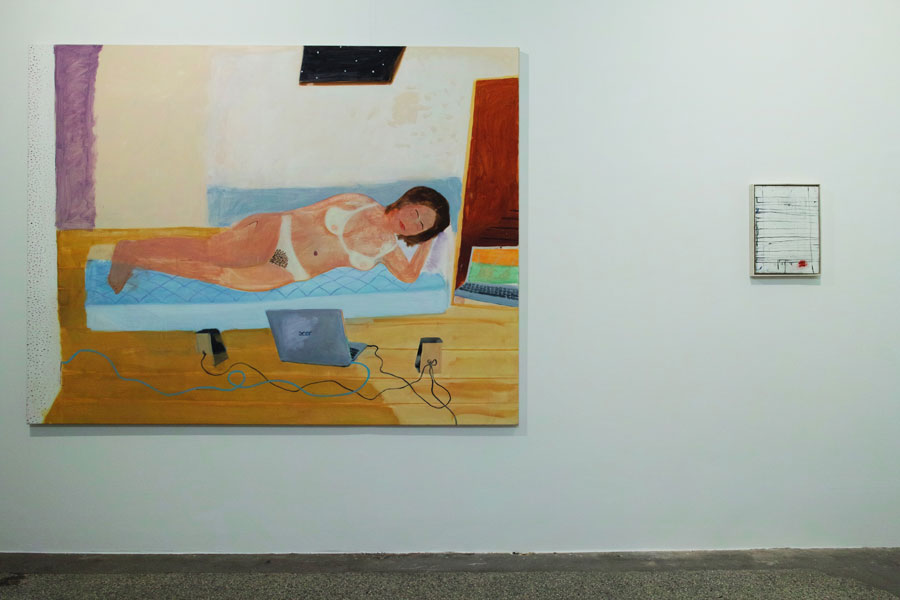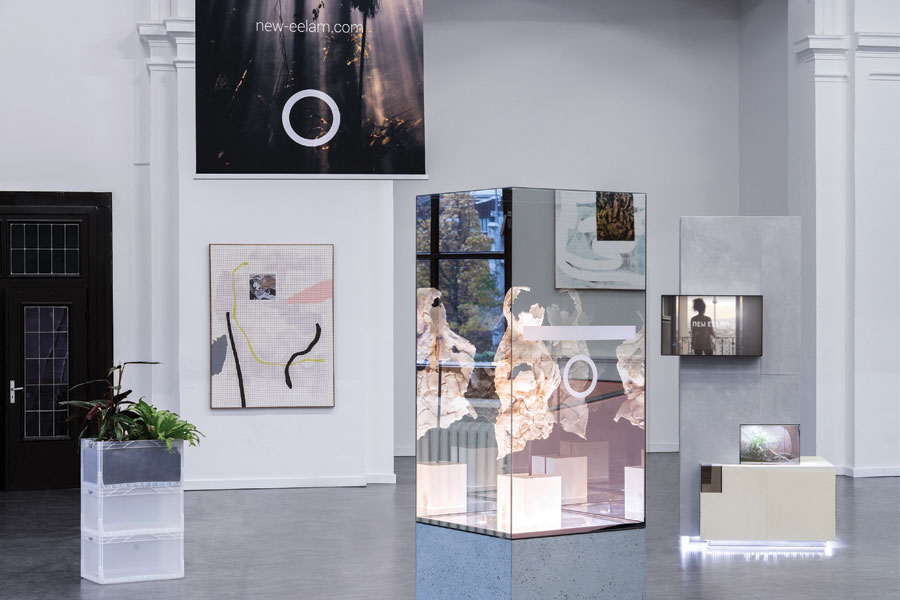Critic’s Guide: Hamburg
Etel Adnan, Andrzej Steinbach, Haegue Yang, and more: a guide to the best shows in the city
Etel Adnan, Andrzej Steinbach, Haegue Yang, and more: a guide to the best shows in the city


Felix Droese
Produzentengalerie Hamburg
11 November – 14 January 2017
The centrepiece of Felix Droese’s solo exhibition at Produzentengalerie Hamburg is a five-metre-long paper cut out depicting six men riding on a bus. In place of wheels are the heads of another two men whose open mouths and wagging tongues suggest they might be screaming. Although it was made in 1992, the ironically titled Reise ins Glück (Journey to Happiness) has lost none of its political potency. Seeing this work, as I did, the day after Donald Trump was elected, felt like a punch in the stomach. It was not a stretch to imagine the men on the bus as half a dozen of America’s 11 million undocumented immigrants being forcibly deported to Mexico, as Trump has promised.
The rest of the exhibition consists mainly of works on paper created between 1970 and 2014, many of which reflect Droese’s interest in the environment, global migration and the movement of capital. While the exhibition isn’t always subtle, perhaps now is not the time to be indirect.

Etel Adnan
Sfeir-Semler Gallery
28 October – 14 January 2017
Etel Adnan’s third show with Sfeir-Semler opens in their ground floor space with a video interview between the 91-year-old artist and curator Hans Ulrich Obrist. Asked by Obrist to talk about non-Western modernity, Adnan gives a fascinating account of the art and literary scenes of her native Beirut over the past 60 years. If, like me, you first discovered the paintings of Etel Adnan at dOCUMENTA (13), this video will go someway to dispelling the myth that the artist, who has been active as a painter and poet in Lebanon since the 1950s, was only ‘discovered’ in 2012.
In the gallery’s second floor space there is a rich mix of tapestries, drawings, writing and paintings. The minimal landscape oil paintings of sunsets and mountains are particularly evocative despite, or perhaps because of, their bold simplicity. Many of the works on display were made in 2016, which one hopes is an indication that Adnan doesn’t plan on slowing down anytime soon.

Andrzej Steinbach
Galerie Conradi
11 November – 22 December
Looking at Andrzej Steinbach’s photographs is a bit like trying to solve a puzzle with a piece missing. Why are seemingly innocuous photographs of a boyish looking young woman (Figur I, Figur II, 2014/15) interrupted with photographs of rocks, such as Untitled (Stone I) (2016)? And what’s the significance of another of his models in Untitled (Reading) (2016) reading the obscure 2015 political manifesto To Our Friends by the collective Invisible Committee? Writing in frieze d/e Moritz Scheper called Steinbach’s photographs ‘both noisy and hermetic.’ I’m inclined to agree. Another series of images show a woman of colour with a short afro, step by step fashioning a t-shirt into a Niqab. I tried to search the photograph for a position on this much-contested item of clothing but instead I found defiance both in the posture of the model and the hand of the photographer.

Haegue Yang
Hamburger Kunsthalle
30 April 2016 – 30 April 2017
This solo presentation by Haegue Yang is the start of a new exhibition format, ‘Uncharted Territory’, that will see the Kunsthalle invite an international artist, dealing with issues of migration, identity, place and belonging, to conceive a show for the institution’s new project space each year. This small but compact exhibition features 17 individual works and is a good introduction to Yang’s idiosyncratic oeuvre. As well as the four new works made for the show, highlights include two Venetian blind installations from the series ‘Sol LeWitt Upside Down’ (2015–ongoing). The last time I saw an iteration of this work was in the cavernous space of Art Basel’s ‘Unlimited’; in the more intimate setting of the Kunsthalle the arrangement had a much more claustrophobic feel, bringing to mind the depressing greyness of office cubicles, especially in comparison to the brightly coloured craftsmanship of the rest of the exhibition.

Lili Reynaud-Dewar
Kunstverein in Hamburg
24 September – 20 November
In Lili Reynaud-Dewar’s solo exhibition at Kunstverein in Hamburg Donna Haraway’s 1985 essay A Cyborg Manifesto takes centre stage, with huge boards leaning against the walls of the exhibition hall displaying passages taken from directly the book. The central video piece TEETH, GUMS, MACHINES, FUTURE, SOCIETY (2016) also focuses on the revolutionary potential of the cyborg but expand Haraway’s ideas to focus on race as well as gender. The video was shot in Memphis, the US city where Martha Luther King was assassinated, and features a group of local comedians discussing cyborgs with each other and the artist. As the video moves towards a final performance, in which a substitute for Reynaud Dewar reads from Haraway’s manifesto, the comedians are given grills to wear over their teeth. This deliberate provocation brings up interesting questions of cultural appropriation, but skirts close to the uncomfortably ethnographic: ultimately the African American men in the group are left to explain the significance of this element of black culture – one that they clearly don’t identify with.

Sebastian Wiegand and Timon Schmolling
Feinkunst Krüger
6 November – 26 November
This is the first joint exhibition at Feinkunst Krüger by these two recent graduates of Hamburg’s Hochschule für bildende Künste. James Ensor’s 1892 painting of a bourgeois study, My Favorite Room, inspired the title, which loosely translates as ‘Lovely new space’. Sebastian Wiegand’s favourite rooms are a little more modest than Ensor’s. In his largest painting kinoto (2016) a woman lies almost naked on a bare mattress; the only other visible objects are a laptop and a pair of speakers. The laptop here seems to work as a self-conscious stamp of contemporariness.
The space in Timo Schmolling’s paintings of lined note paper appear at first to be equally empty, but on closer inspection certain details appear: a hint of a lipstick here, the outline of clouds there, as if the artist tried for abstraction but couldn’t quite keep figuration out of the frame.

Christopher Kulendran Thomas
Kunstverein Harburger Bahnhof
4 November – 12 February 2017
The central premise of Kulendran Thomas’ start up company, New Eelam, is a network of communally owned apartments spread across the world that, for a monthly flat rate price, participants would be free to move between, thereby creating a more ‘liquid form of citizenship’. For EasyJet country hoppers like myself this is a seductive proposition, but one that only seems realistic because my British passport (at least for now) allows me the right to enter 28 countries without a visa.
For his exhibition at Kunstverein Harburger Bahnhof, his first institutional solo in Germany, Kulendran Thomas presents New Eelam (2016–ongoing) through slick video adverts mounted onto interior design inspired modules. Dispersed throughout the exhibition are works of art from Sri Lanka, purchased by the artist during what he calls the ‘“peacetime” contemporary art boom’, and reconfigured into his own installations, a practice that he started in 2013. The adverts themselves are full of aspirational symbols of the creative classes, such as Eames chairs and New Tendency side tables, the kind I, and many others, lust over on Instagram. While it remains to be seen how this project takes shape, Kulendran Thomas certainly knows his audience.
Main image: Haegue Yang, Sonic Half Moon Type IV–Medium Light #19 (detail), 2014, steel frame, metalgrid, powder coating, brass plated bells, nickel plated bells, metal rings, steel wire. Courtesy: Galerie Chantal Crousel, Paris, installation view Galerie Chantal Crousel booth, Art Basel Miami Beach, Miami, USA, 2014, photograph: Sebastiano Pellion di Persano





















